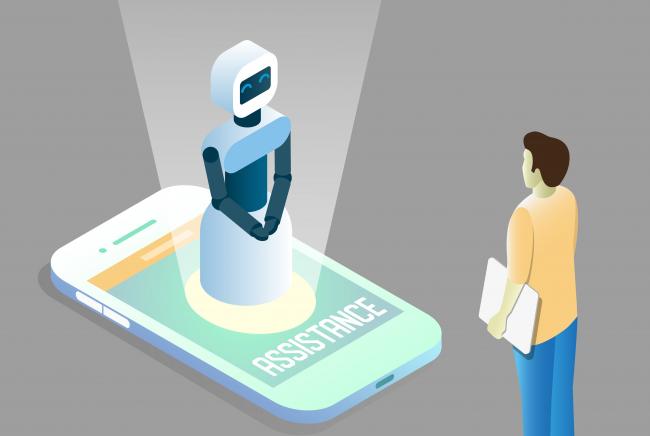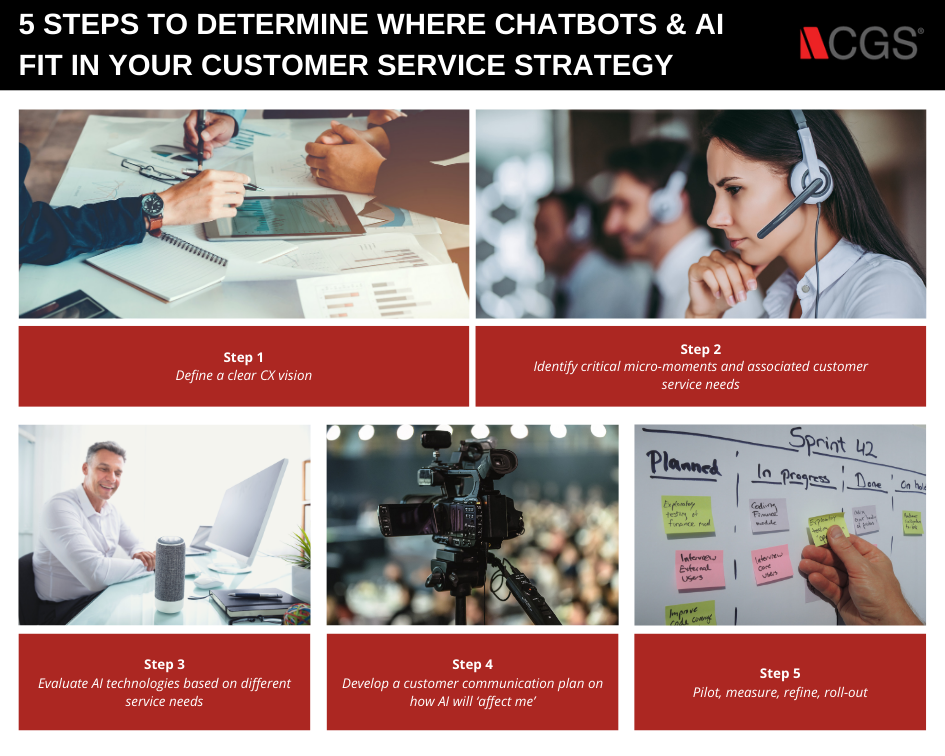Christine Crandell is a 25-year expert in market strategy, and building successful, profitable organizations. Her work with CEOs and Board of Directors helps them understand how to optimize their strategy, build data-driven marketing organizations that thrive on driving revenue, and align their organizations to deliver high-value customer experiences across all touchpoints. She has advised over 100 CEOs and Board of Directors in North America, Europe and Australia in areas including market category creation, company strategy, go-to-market, marketing management, and how to align people, processes and technology outward to deliver customers’ expectations that drive company performance.
Where Chatbots and AI Fit into Your CX Strategy

Customers expect and use multiple channels to access customer support. “Most customers will still prefer to use an automated or self-service option as long as it is convenient and easy to understand,” says Jeff Toister, author of The Service Culture Handbook, “because when a customer does want to connect with a human, it’s almost always because something is either urgent or complicated.”
During the recent California mass power outage everything powered by electricity – Internet Wifi, traffic lights, expresso machines – was brought to a halt. The sheer volume of over 700,000 residents looking for information also brought the PG&E website, chatbots and call centers to their knees.
The 2019 CGS Customer Service Chatbot and Channel Survey found that AI technology implementations are happening faster than customers are able, or willing, to embrace them. And signs of a backlash are present. Only 30 percent of study respondents believe that chatbots and virtual assistants make it easier to resolve issues. And it’s not a difference of generations. Respondents younger than 35 years of age were 43 percent confident in AI-based solutions. That is not an overwhelming endorsement considering that 71 percent of respondents said they would be less likely to use a brand if it didn’t have human customer service representatives. Jeanne Bliss’, of CustomerBliss, observations also rang loud and true “You may need less people on the phone, but you need a higher caliber, a person who can understand the situation and solve it in one call.”
Customers do not see AI as complete, helpful, knowledgeable or empathetic enough to replace a human support agent. The best approach is a hybrid one – AI-powered tools to address routine, repetitive customer inquiries and human representatives to help customers with urgent and/or complex situations.
“Chatbots and virtual assistants are using a combination of natural language processing, traditional analytics, supervised learning and voice recognition”, said Mark Rabkin, Director AI Strategy & Innovation for Software AG. They have made a noticeable impact on customer experience (CX).
“AI is an enabler. It’s not an end unto itself,” shared Bliss. “You have to first craft customer goals and experiences, then figure out what tools are right to improve them. Versus starting with where are we going to pop it in?”
Company culture and how it builds customer relationships can make or break AI adoption. The human component is critical when automating customer-facing touchpoints.

Step 1: Define your CX vision
Start with clearly defining your CX vision which Toister describes as “a compass that always points you in the right direction when you’re creating a customer experience. Technically, it’s really just a shared definition of an outstanding experience." [1]
Step 2: Identify critical micro-moments and associated service needs
Develop a detailed understanding of your customers’ journey(s), key micro-moments and associated emotions. It’s critical to focus on building a reliable and sustainable service engine that translates into what Bliss refers to as service quality.
Begin by identifying micro-moments where positive emotions of appreciated, confident, delighted, happy, respected, and valued are critical for customer loyalty. Alternatively, highlight micro-moments where anger, annoyance, disappointment and frustration are high. The objective is to determine those micro-moments where automation can create positive experiences.
Step 3: Evaluate AI technologies based on different service needs
Once the micro-moments and associated customer expectations are defined, you’re ready to look at automation technology. Since there are over 8,000 AI vendors [2], begin by understanding the various technologies and approaches. Use the target outcome for each micro-moment as a guide to determine which approach is right for each interaction.
Toister shares, “Only then should you consider various technologies to improve service. If you marry to one specific tool or technology from the beginning, you’re doomed.” That means you may have a mix of technologies, some for the long term, some for only a short amount of time. Evaluate each vendor’s technology roadmap to understand how well their roadmap aligns with your CX vision and customer goals.
Step 4: Develop a customer communication plan on how AI will ‘affect me’
All too often, communicating how technology implementations impact the end-user gets left until last. That can result in failure of an otherwise successful roll-out. The bottom-line is people don’t like change and feeling blind-sided. Develop a communication plan and timeline for how you will communicate new automation to customers and end-users.
What customers want to know is: When will this happen, what will be different, what will it look like, where do I go for help, and why are you doing this. Use all the channels and repeat the message often.
Step 5: Pilot, measure, refine, roll-out
Start by piloting a few key micro-moments where you clearly understand the customers’ expectations. Does automation eliminate friction for the customer? Have your team manage the pilots; don’t throw it over the wall to the vendor(s) or consultants.
Define the metrics you’ll use to measure success including NPS, sentiment analysis, CSAT, abandonment, etc. Ask your customer advisory board, user groups, and/or social media communities to give you candid feedback on the pilot. By collaborating and co-creating with customers and users, you’ll shorten the process and have success faster.
CGS states automation, artificial intelligence (AI), and chatbots should not be done at the expense of the customer journey. AI will enable a productivity and efficiency boom and reshape customer experiences. But we’re in the early stages. The market forecast for chatbot technology is expected to grow from $190.8Million in 2016 to $1.25Billion in 2025 [3]. It’s important to keep in mind that the critical success factor is not the technology but how it is used to deliver a customer experience that delights and builds your brand’s service quality reputation.
[1] https://www.statista.com/statistics/656596/worldwide-chatbot-market/
[2] https://cloudcherry.com/blog/what-exactly-is-a-cx-vision/
[3] https://www.forbes.com/sites/cognitiveworld/2019/02/14/classifying-the-a...
Christine Crandell is a 25-year expert in market strategy, and building successful, profitable organizations. Her work with CEOs and Board of Directors helps them understand how to optimize their strategy, build data-driven marketing organizations that thrive on driving revenue, and align their organizations to deliver high-value customer experiences across all touchpoints. She has advised over 100 CEOs and Board of Directors in North America, Europe and Australia in areas including market category creation, company strategy, go-to-market, marketing management, and how to align people, processes and technology outward to deliver customers’ expectations that drive company performance.

